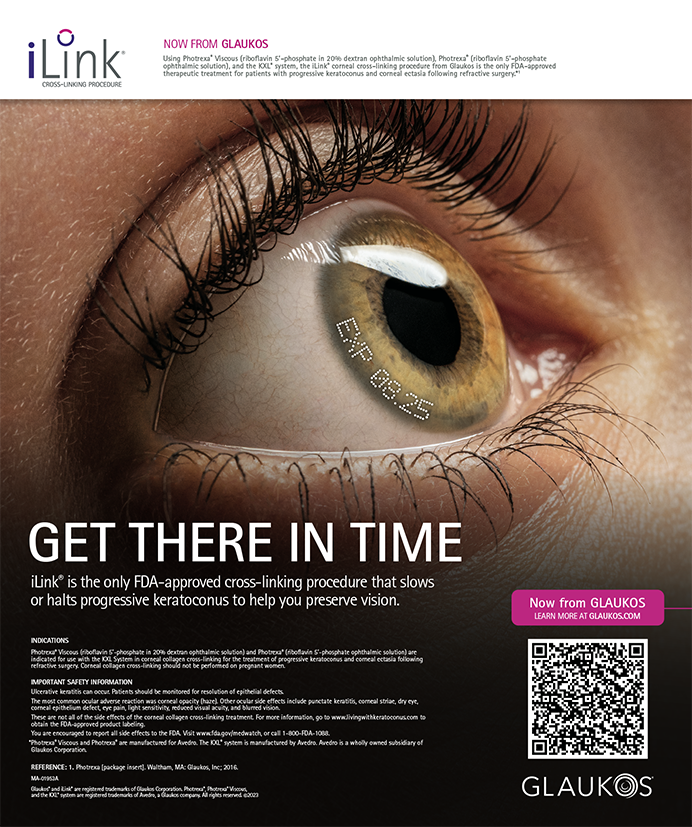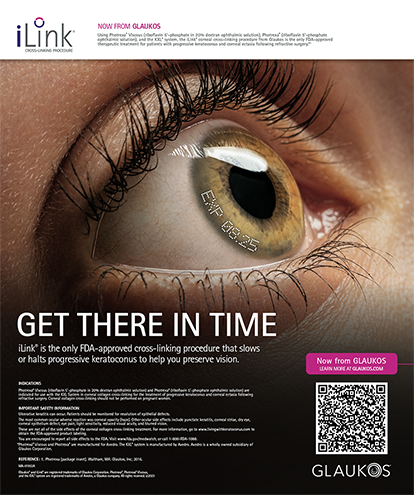“No man is an island, entire of itself; every man is a piece of the continent, a part of the main.”
—John Donne

For many of us, when we chose a career in ophthalmology, we stepped onto a medical island, uniquely separated from other fields in medicine by an expansive sea of exclusive terminology and diagnostic instruments. In what other field of medicine can the most basic of examinations not be conducted without an instrument—an instrument not even included in most medical school curricula? What other group of doctors produces chart consultations replete with jargon and schematics virtually uninterpretable by the requesting physician? What other group of medical professionals cannot bring themselves to call right eyes right eyes and left eyes left eyes but relates better to the Latin, oculus dexter and oculus sinister? It is no wonder ophthalmology exists on an island! And, let us face it, many of us like it this way.
However, we face new challenges in medicine. With increasing regulation, looming financial penalties, and a trend toward declining reimbursement schedules, we now face a choice. On the one hand, we can make our island bigger by hiring more doctors, by combining with smaller practices, or by surrendering our land to the large, private-equity corporate ships that sail our waters. On the other hand, we can build bridges to the mainland. We can try to find new connections to those other fields of medicine that have been lost on our horizons.
We have already built some bridges, for example, to the regions of cornea, glaucoma, and retina. These together constitute the conventional idea of multispecialty practices, but they are really multisubspecialty practices. What if we dared to build bridges to our neighbors outside of eye care? Instead of growing in size, what if we grew in diversity?
NATURAL INTEGRATION
Certain specialties within medicine naturally integrate with ophthalmology. I have the privilege of practicing in a group that integrates ophthalmology with dermatology, plastic surgery, and podiatry. This version of integration is distinctly different from the typical grouping of disparate specialties sharing space in a common building or sharing lease payments with a common management company. Instead, this is a veritable interconnectedness with active cross-referral protocols, a common electronic health record system, shared marketing efforts, and a cross-trained staff. There are two operating suites, a medical spa, and a large retail area showcasing everything from medical skin care products to boutique spectacle frames. Although we are separated into different waiting areas and clinical spaces, the overall practice promotes all of the specialties in all of the spaces using tasteful print and video marketing material.
Integrating specialties from outside of ophthalmology generates novel sources of referrals. With many medical conditions requiring the collective efforts of specialties such as dermatology, podiatry, and ophthalmology, it is easy to establish protocols for trigger diagnoses that generate cross-referrals within the practice. In addition, plastic surgery patients presenting for breast augmentation or facelift procedures (or their family members in the waiting room) may also be interested in laser refractive surgery or premium cataract surgery. Blepharoplasty patients can be actively managed for dry eye disease before and after their surgeries. This type of cross-pollination naturally diversifies the payer mix, promoting both insurance payments and cash payments, and it allows unique flexibility during changing economic times.
PATIENTS’ CONVENIENCE
From the patient’s perspective, this type of integration provides exceptionally easy access to care and an unprecedented sense of convenience. Many academic institutions have popularized the concept of executive care designed to accommodate the busy professional who desires a head-to-toe workup in one place at one time. Imagine the satisfaction of the patient who discovers she can get her mole checked, eyes examined, and dermal filler injected seamlessly in one appointment; the diabetic patient who can have his feet examined on the same day as his cataract evaluation; or the postoperative facelift patient looking for a pair of designer sunglasses.
Whether a patient wishes to use medical insurance for a full-body wellness check or desires a full cosmetic enhancement, including a facelift and refractive lens exchange, he or she can expect both programs of care to be available here. Patient coordinators, cross-trained in the logistics and finances of our diverse specialties, can provide the links between appointments, promoting the cohesiveness of the patient’s medical experience.
LIFESTYLE HEALTH
The addition of dermatology, plastic surgery, and medical aesthetics permits participation in a growing trend in medicine known as lifestyle health. This relatively new categorization builds a positive construct around aging and chronic disease, empowering patients to better understand and manage their disease state. Lifestyle health emphasizes prevention, treatment, and enhancement, and it invites patients not only to seek care for disease but also to actively contribute to their sense of wellness and beauty. In addition, lifestyle health naturally supports the addition of an internist to the multispecialty group, particularly an internist dedicated to promoting prevention and wellness programs. Weight-loss programs, for example, can blend very well into this model of care.
Providing care not only to the eyes but also to the person behind the eyes opens myriad possibilities. This novel concept emphasizes convenience and completeness to the patient while maximizing growth and diversity for the practice.
Financial advisors constantly remind clients to diversify their portfolios. Should we ophthalmologists not apply that wisdom to our practices as well? As we face growing uncertainty in medicine, as we face increasing pressure to expand our practice revenue, are we truly confined to the bloated realities of hiring more eye doctors, buying more practices, cramming in more surgeries, or selling our souls to corporate giants? Surely, there must be a more elegant way of navigating the uncharted waters of modern-day medicine. Perhaps therein lies the value of the idea of partnering with specialties outside ophthalmology.
PART OF MEDICINE
Instead of growing bigger in size, maybe we should try growing bigger in scope. As we sit on our island of eye care, maybe it is time to start building new bridges to our neighboring specialties. We can still have our oculi dexter and oculi sinister. We can still be the only specialty with Current Procedural Terminology codes beginning with the number 92. We can even still be the only ones who can find the power switches on our slit lamps.
However, as we learned as medical students and as residents, ophthalmology really is a part of medicine. Maybe it is time not only to learn that but also to practice it. Sure, we could continue to grow the size of our island and to convince ourselves the sun shines only here, but how many more acres of sunshine there could be on the mainland.
Richard A. Adler, MD
• director at Belcara Health Ophthalmology
• assistant professor of ophthalmology at Wilmer Eye Institute, Baltimore
• dradler@belcarahealth.com


